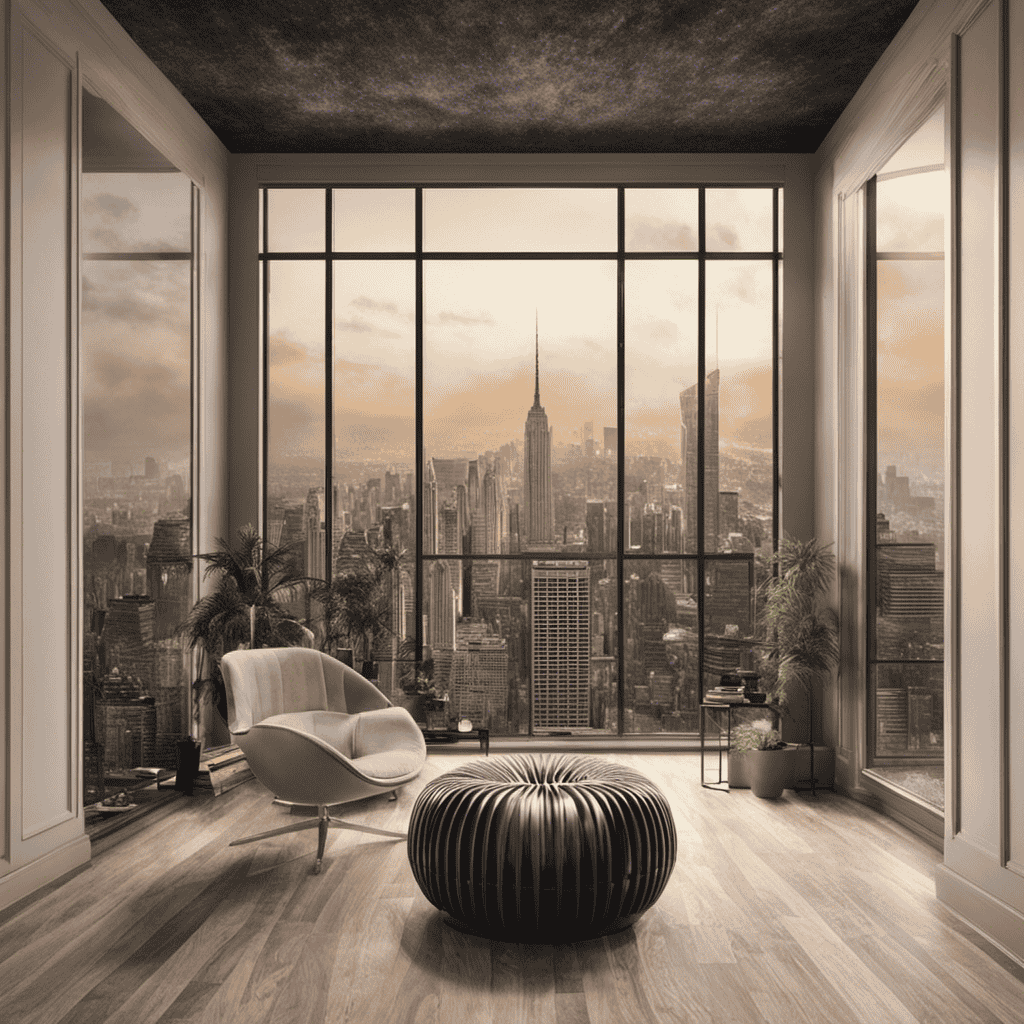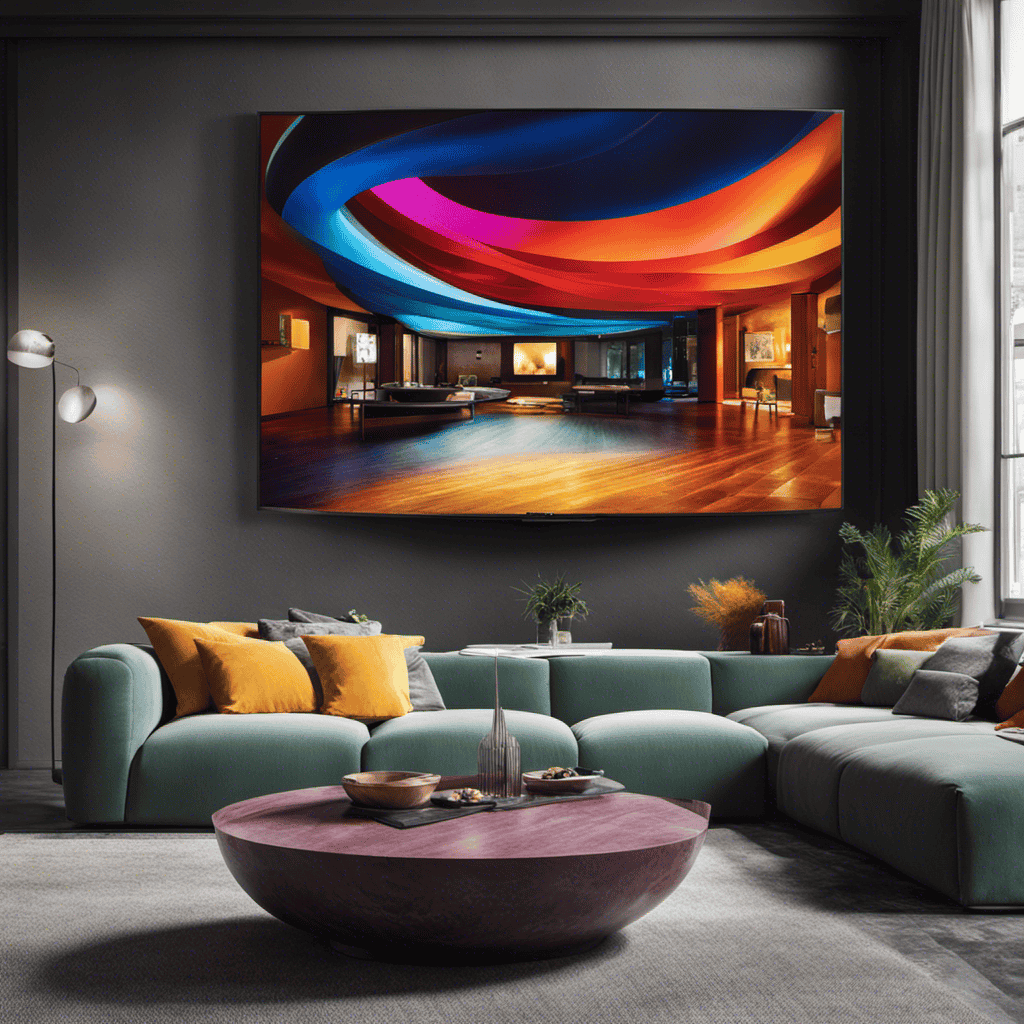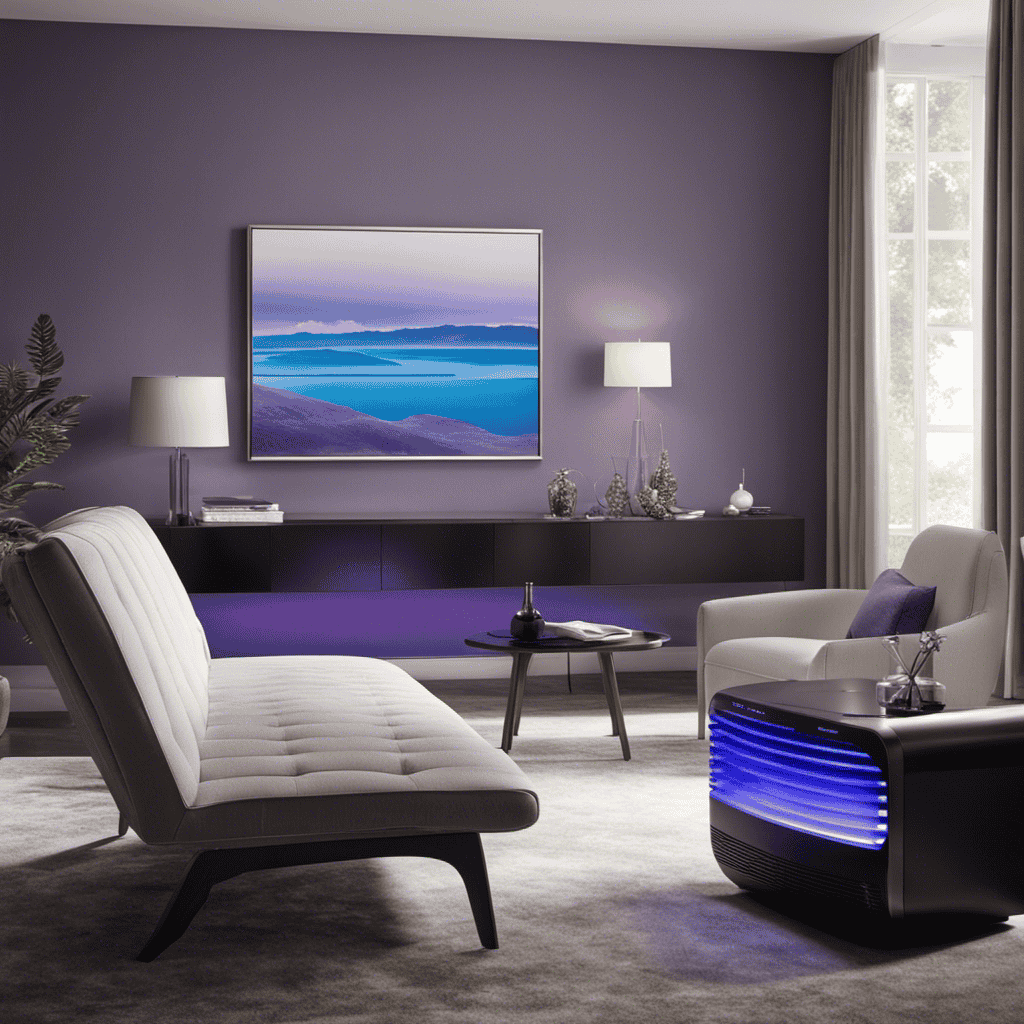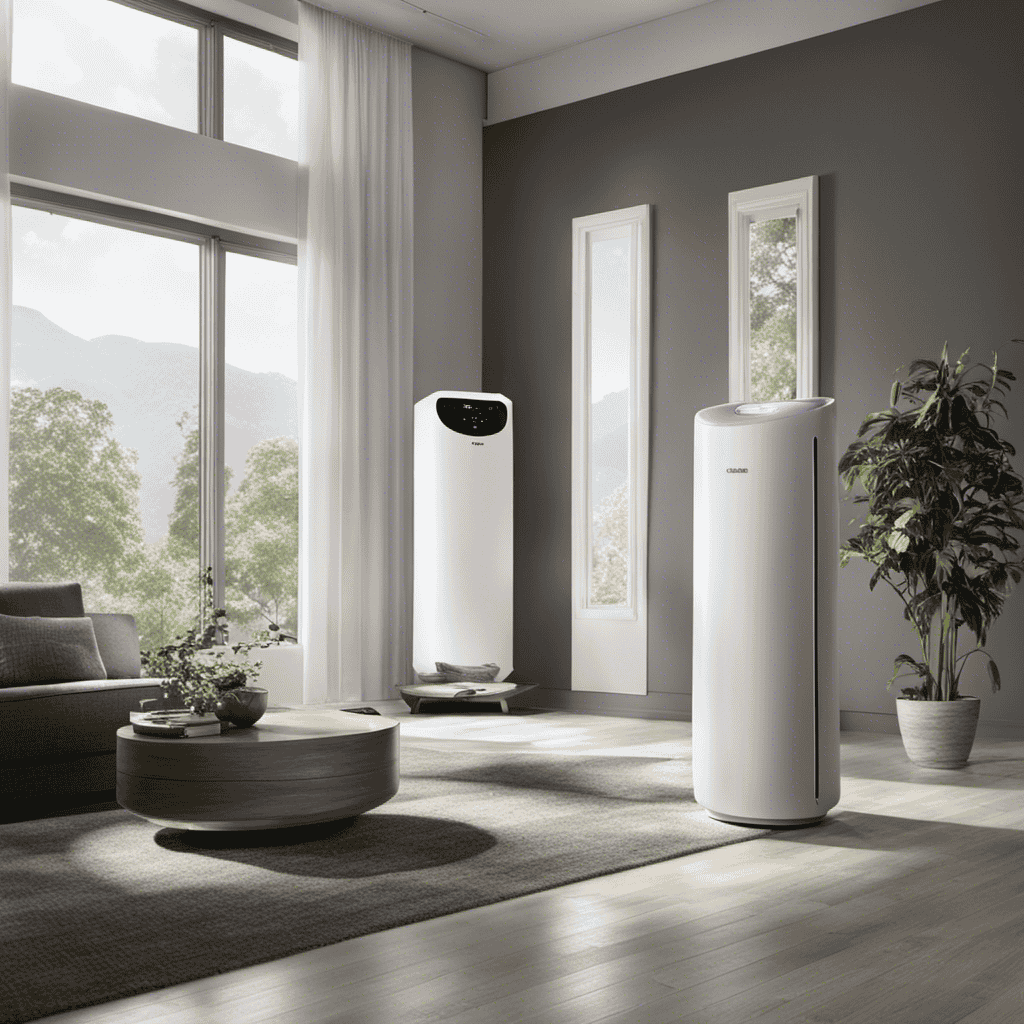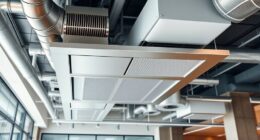Have you ever thought about how we can improve the quality of the air we breathe? Let me introduce you to the world of air purifiers, where we can make our air cleaner and healthier.
These nifty devices work tirelessly to remove impurities from the air, allowing us to breathe in a fresh and purified atmosphere. From their humble beginnings to the advanced filtration systems they employ today, air purifiers have come a long way.
So, join me on this informative journey as we explore the inner workings of these remarkable machines.
Key Takeaways
- Air purifiers use multiple filtration technologies, such as HEPA filters, activated carbon filters, and UV-C light, to remove pollutants from the air.
- HEPA filters are highly efficient at capturing particles as small as 0.3 microns with a 99.97% efficiency rating.
- Activated carbon filters are effective at removing odors and chemicals, while UV-C light destroys bacteria, viruses, and mold spores.
- Regular maintenance, including cleaning or replacing filters, is crucial for optimal performance and to ensure clean and healthy indoor air.
History of Air Purifiers
So, how does an air purifier work? Well, let me tell you about the history of air purifiers.
The development of air purifiers can be traced back to the early 1800s when the first rudimentary systems were introduced. The initial designs focused on removing dust particles from the air using various methods like mechanical filters and electrostatic precipitation.
Over time, advancements in technology and understanding of air pollution led to the development of more sophisticated air purifiers that could also eliminate harmful gases and odors. In the mid-1900s, air purifiers became more popular as people became more aware of the health risks associated with indoor air pollution.
Today, air purifiers have evolved into highly efficient devices that use multiple filtration technologies to remove a wide range of pollutants from the air.
Now, let’s move on to discussing the different types of air purifiers.
Types of Air Purifiers
When it comes to filter effectiveness comparison and weighing the pros and cons, it is important to consider the specific needs and priorities of each individual.
Different types of air purifiers offer varying levels of effectiveness in capturing and removing pollutants from the air.
While some filters may excel in removing particles like dust and pollen, others may be more efficient in eliminating odors or harmful gases.
Taking into account factors such as cost, maintenance requirements, and target pollutants can help determine the most suitable air purifier for a particular setting.
Filter Effectiveness Comparison
To compare the effectiveness of filters in air purifiers, you should look at their respective ratings and customer reviews. Different filters have varying levels of efficiency in removing pollutants from the air. A cost effectiveness analysis can help you determine which filter type is the best choice for your needs. Here is a comparison of five common filter types:
| Filter Type | Efficiency Rating |
|---|---|
| HEPA | 99.97% |
| Activated Carbon | 99% |
| Ionizer | 99% |
| UV-C | 99.9% |
| Electrostatic | 95% |
Based on the table, HEPA filters have the highest efficiency rating, followed closely by activated carbon, ionizers, and UV-C filters. Electrostatic filters have a slightly lower efficiency rating. Consider the cost of replacement filters and the specific pollutants you are trying to remove when making your decision.
Pros and Cons
If you’re looking for an air purifier, it’s important to consider the pros and cons of each type of filter.
Different filters offer varying levels of effectiveness in removing pollutants from the air. HEPA filters, for example, are highly efficient at capturing particles as small as 0.3 microns, including allergens, dust, and pet dander. They can greatly improve indoor air quality and provide significant health benefits, especially for individuals with respiratory conditions or allergies. However, HEPA filters may need frequent replacement and can be costly.
On the other hand, activated carbon filters excel at removing odors and chemicals from the air, but they may not be as effective in capturing smaller particles.
It’s crucial to weigh the benefits and drawbacks of each filter type to make an informed decision based on your specific needs and priorities.
Purpose of Air Purifiers
Air purifiers play a crucial role in improving air quality by removing allergens and pollutants from the surrounding environment. These devices work by using filters and other technologies to capture and trap particles such as dust, pollen, pet dander, and smoke, helping to reduce respiratory irritation and discomfort.
With their ability to effectively remove these harmful substances, air purifiers provide a much-needed solution for individuals who suffer from allergies or respiratory conditions, and for anyone looking to create a cleaner and healthier living space.
Air Quality Improvement
Improving the air quality in your home is as simple as using an air purifier. Air purifiers are equipped with advanced technology that effectively filters out pollutants and improves indoor air quality.
Here are three ways air purifiers work to combat indoor air pollution:
-
Filtration: Air purifiers use filters to trap and remove particles such as dust, pollen, pet dander, and mold spores from the air. HEPA filters, in particular, are highly efficient in capturing even the smallest particles.
-
Activated Carbon: Many air purifiers also feature activated carbon filters. These filters are effective in removing odors, gases, and chemical pollutants from the air, ensuring a fresher and cleaner environment.
-
UV-C Light: Some air purifiers use UV-C light technology to eliminate airborne bacteria and viruses by breaking down their DNA structure. This helps reduce the risk of respiratory infections and keeps the air in your home healthier.
Allergen and Pollutant Removal
Utilizing advanced technology, air purifiers effectively filter out allergens and pollutants, creating a healthier indoor environment.
Air purifier technology has come a long way in recent years, with the development of highly efficient filters and innovative purification methods. These devices work by drawing in air from the surrounding environment and passing it through a series of filters.
These filters are designed to capture various types of contaminants, such as dust, pollen, pet dander, mold spores, and even volatile organic compounds (VOCs) emitted by household products. By removing these allergens and pollutants from the air, air purifiers help to improve indoor air quality.
This is especially beneficial for individuals who suffer from allergies or respiratory conditions, as it reduces their exposure to triggers that can worsen their symptoms.
Components of an Air Purifier
To understand how an air purifier works, you need to know about its various components. Here are the key elements that make up an air purifier:
-
Air filters: These are the heart of an air purifier. They capture and remove contaminants from the air, such as dust, pollen, pet dander, and smoke.
-
Fan: The fan in an air purifier helps to circulate the air, ensuring that it passes through the filters for effective purification.
-
Air quality sensors: Some air purifiers are equipped with sensors that monitor the air quality in the room. These sensors detect pollutants and allergens and adjust the purifier’s operation accordingly.
Air purifiers utilize advanced technology to improve indoor air quality. They can efficiently remove airborne particles, providing cleaner and healthier air.
Now, let’s delve into the filtration process of air purifiers and how it further enhances their efficiency.
Filtration Process of Air Purifiers
After understanding the components of an air purifier, let’s delve into the filtration process and the advancements in air purifier technology.
The filtration process is the heart of an air purifier, as it is responsible for removing contaminants from the air. Most modern air purifiers use a combination of filtration technologies, such as HEPA filters, activated carbon filters, and UV-C light.
These advancements have greatly improved the efficiency and effectiveness of air purifiers in removing pollutants and allergens from the air. However, it’s important to note that regular maintenance is crucial to ensure optimal performance.
This includes regularly cleaning or replacing filters, cleaning the unit itself, and ensuring proper airflow. By keeping up with maintenance and taking advantage of the latest technology advancements, air purifiers can provide cleaner and healthier air for our homes and workplaces.
How HEPA Filters Work
When it comes to improving indoor air quality, one of the most effective tools is a HEPA filter.
These filters are designed to capture and remove airborne particles, such as dust, pollen, pet dander, and mold spores.
With their high efficiency, HEPA filters can help to reduce allergens and improve overall air quality in homes and workplaces.
HEPA Filter Effectiveness
You may wonder how effective HEPA filters are at removing small particles from the air. Well, let me tell you, based on my research and analysis, HEPA filters are highly effective in capturing and removing particles as small as 0.3 microns. Here are three key factors that contribute to the effectiveness of HEPA filters:
-
Filtration Efficiency: HEPA filters are designed to have a high filtration efficiency of 99.97%. This means that they can remove almost all airborne particles, including dust, pollen, pet dander, and even some bacteria and viruses.
-
HEPA Filter Lifespan: The lifespan of a HEPA filter can vary depending on usage and air quality. On average, HEPA filters can last anywhere from 6 to 12 months. Regular maintenance, such as vacuuming or washing the filter, can help prolong its lifespan.
-
HEPA Filter Maintenance: Proper maintenance is crucial to ensure the effectiveness of HEPA filters. This includes regular cleaning or replacement of the filter, as well as keeping the air purifier clean and free from dust and debris.
Airborne Particle Removal
To effectively remove airborne particles, it’s important to regularly clean or replace the filter in your HEPA air purifier. HEPA, or High Efficiency Particulate Air, filters are designed to capture particles as small as 0.3 microns with an efficiency of 99.97%. This technology has been widely adopted due to its effectiveness in improving indoor air quality.
According to air quality standards, HEPA filters are recommended for individuals with allergies or asthma, as they can help reduce allergens, pollen, pet dander, and dust mites in the air. It’s crucial to maintain the filter’s efficiency by cleaning or replacing it as recommended by the manufacturer. By doing so, you can ensure that your air purifier continues to effectively remove airborne particles and provide you with cleaner and healthier air.
Now let’s explore another important component of air purification: activated carbon filters.
Activated Carbon Filters and Air Purification
If you’re looking to improve your indoor air quality, activated carbon filters are a key component of air purifiers. These filters are designed to remove volatile organic compounds (VOCs) from the air, which can be harmful to your health.
Here’s how activated carbon filters work:
-
Adsorption: The carbon in the filter attracts and traps VOC molecules, effectively removing them from the air.
-
Large Surface Area: Activated carbon filters have a large surface area, allowing for more adsorption and efficient removal of pollutants.
-
Chemical Reaction: As VOCs come into contact with the carbon, a chemical reaction occurs, breaking down the pollutants and making the air cleaner.
UV-C Light and Air Purification
When it comes to air purification, UV-C light has proven to be highly effective.
UV-C light works by destroying the DNA and RNA of microorganisms, rendering them unable to reproduce and effectively killing them.
The benefits of UV-C light in air purification include its ability to eliminate bacteria, viruses, and mold spores, making it a powerful tool in creating cleaner and healthier indoor environments.
UV-C Effectiveness in Purification
You’ll be pleased to know that UV-C light is highly effective in purifying the air. This technology has been widely used in air purifiers to eliminate harmful germs and bacteria. Here are three reasons why UV-C technology is so effective:
-
Kills germs: UV-C light has the power to destroy the DNA of microorganisms, including bacteria, viruses, and mold spores. By disrupting their genetic material, it prevents them from reproducing and renders them harmless.
-
Sterilizes the air: When air passes through an air purifier equipped with UV-C technology, the UV-C light targets and neutralizes airborne pathogens. This process ensures that the air you breathe is free from harmful germs and allergens.
-
Prevents recontamination: Unlike filters, UV-C light doesn’t just trap pollutants; it actively eliminates them. By continuously emitting UV-C light, air purifiers can prevent the growth and spread of germs, ensuring a cleaner and healthier environment.
Benefits of UV-C Light
Moving on from the effectiveness of UV-C light, let’s now explore the benefits of this disinfection technology in air purifiers. UV-C light, with its germicidal properties, offers a powerful solution for improving air quality. By harnessing the power of short-wavelength ultraviolet light, air purifiers equipped with UV-C technology can effectively neutralize harmful bacteria, viruses, and mold spores present in the air. This ensures that the air we breathe is cleaner and healthier, reducing the risk of respiratory illnesses. To help you visualize the advantages of UV-C technology, here is a table highlighting its benefits:
| Benefits of UV-C Light |
|---|
| Kills bacteria and viruses |
| Neutralizes mold spores |
| Improves overall air quality |
With these benefits in mind, let’s now delve into the next section, where we will explore the role of ionizers and air purification in further enhancing the cleanliness of our indoor air.
Ionizers and Air Purification
Ionizers are devices that help improve air quality by releasing negatively charged ions into the air, which attach to airborne particles and remove them from the surrounding environment.
Here are three important facts about ionizers and their impact on air purification:
-
Ionizers and ozone: While ionizers can effectively remove particles from the air, they also have the potential to produce ozone as a byproduct. Ozone is a gas that can be harmful to human health when present in high concentrations. It is important to choose ionizers that have low ozone emission levels to minimize any potential risks.
-
Ionizers and respiratory health: Ionizers can be beneficial for individuals with respiratory conditions such as asthma or allergies. By removing airborne particles like dust, pollen, and pet dander, ionizers can help reduce triggers and improve indoor air quality, leading to better respiratory health.
-
Considerations for use: It is important to note that ionizers are most effective in smaller enclosed spaces. They may not be as effective in larger areas or spaces with high levels of pollutants. Regular cleaning and maintenance of ionizers is also necessary to ensure optimal performance and prevent the accumulation of particles on the device itself.
Ozone Generators and Air Purification
In the previous subtopic, I discussed ionizers and their role in air purification. Now, let’s delve into another method called ozone generators.
Ozone generators work by producing ozone, a gas that is known for its ability to eliminate odors and kill bacteria and viruses. When ozone comes into contact with pollutants in the air, it oxidizes them, breaking them down into harmless substances. However, it is important to note that ozone can have harmful effects on human health.
High levels of ozone can irritate the respiratory system and cause breathing difficulties. Therefore, it is crucial to use ozone generators with caution and follow safety guidelines to prevent any adverse effects. Despite its effectiveness in air purification, it’s essential to prioritize ozone safety when using ozone generators.
Transitioning into the subsequent section about electrostatic precipitators and air purification, let’s explore another method for improving indoor air quality.
Electrostatic Precipitators and Air Purification
Remember, when using electrostatic precipitators, it’s important to regularly clean the collection plates to maintain their effectiveness in removing particles from the air.
Here’s why electrostatic precipitators are an effective solution for air pollution control:
-
Charged Particles: Electrostatic precipitators use an electrical charge to ionize particles in the air. This causes them to become charged and stick to the collection plates.
-
High Efficiency: These devices have a high efficiency rate, typically ranging from 95% to 99%. They can effectively remove both large and small particles, including dust, smoke, and pollen.
-
Cost-effective: Electrostatic precipitators are a cost-effective solution for air pollution control. Once installed, they have low operating costs and require minimal maintenance.
Benefits of Using an Air Purifier
After discussing electrostatic precipitators and their role in air purification, let’s now explore the benefits of using an air purifier.
Indoor air pollution is a significant concern, as it can have a detrimental impact on respiratory health. Air purifiers help alleviate this issue by removing harmful pollutants and allergens from the air we breathe.
By using various filtration technologies, such as HEPA filters, activated carbon filters, or UV germicidal lamps, air purifiers can effectively trap and eliminate particles like dust, pollen, pet dander, mold spores, and even bacteria and viruses. This can greatly improve indoor air quality and reduce the risk of respiratory problems like allergies, asthma, and respiratory infections.
Regular use of an air purifier can create a cleaner and healthier environment, promoting better respiratory health for everyone in the space.
Factors to Consider When Choosing an Air Purifier
When choosing an air purifier, there are several factors to consider. First, think about the size of the room and the specific pollutants you want to target. This will help you determine the appropriate size and type of air purifier for your needs.
Next, consider the energy consumption of the air purifier. Look for models that are energy-efficient and have the ENERGY STAR certification. This will not only help you save on electricity bills but also ensure that the purifier meets strict energy efficiency guidelines.
Another important factor to consider is the noise level of the air purifier. If you plan to use it in a bedroom or office space, you’ll want to look for models that have a low noise level or a noise reduction feature. This will prevent the purifier from disrupting your sleep or work.
Lastly, evaluate the filtration system of the air purifier. HEPA filters are highly effective in capturing small particles, while activated carbon filters are great for removing odors and chemicals. Choose a purifier that has the right combination of filters to target your specific pollutants.
Considering these factors will help you find an air purifier that suits your needs and preferences. Now, let’s delve into maintenance and care for air purifiers.
Maintenance and Care for Air Purifiers
To keep your air purifier running efficiently, it’s important to regularly clean or replace the filters. The filters in an air purifier are responsible for capturing and removing airborne particles, such as dust, pollen, and pet dander. Over time, these filters can become clogged with debris, reducing the effectiveness of the purifier. Regular maintenance will ensure that your air purifier continues to provide clean, fresh air for you and your family.
Here are some maintenance tips to keep in mind:
- Clean or replace filters every 3-6 months, or as recommended by the manufacturer.
- Vacuum the exterior of the purifier to remove any dust or dirt buildup.
- Check the fan and motor for any signs of damage or wear.
- Keep the surrounding area clean to minimize the amount of airborne particles entering the purifier.
Common Misconceptions About Air Purifiers
One of the most common misconceptions about air purifiers is that they are only effective for people with allergies. However, this belief is far from the truth. Air purifiers play a vital role in improving respiratory health for everyone, regardless of whether they suffer from allergies or not.
Here are three air purifier myths debunked:
-
Myth: Air purifiers only remove allergens.
Fact: While they are highly effective at removing allergens like pollen and pet dander, air purifiers also eliminate other harmful particles such as dust, mold spores, and smoke. -
Myth: Air purifiers are noisy and disruptive.
Fact: Modern air purifiers are designed with advanced technology that minimizes noise levels, allowing you to enjoy clean air without any disturbance. -
Myth: Air purifiers are expensive to operate.
Fact: Air purifiers are energy-efficient devices that consume minimal electricity, making them affordable to run continuously for long periods.
Frequently Asked Questions
Can Air Purifiers Remove All Types of Air Pollutants?
Yes, air purifiers are effective in removing various types of air pollutants. However, it’s important to note that they have limitations and may not be able to eliminate all pollutants, such as certain gases or odors.
How Often Do Air Filters Need to Be Replaced in an Air Purifier?
I’ll share my knowledge about air filter maintenance. It’s important to know when to replace them. Signs of a dirty air filter include reduced airflow and increased dust accumulation.
Can Air Purifiers Help With Allergies and Asthma?
Yes, air purifiers can help with allergies and asthma. They remove allergens and irritants from the air, reducing symptoms. While they are not a substitute for medication, using them long term can have positive effects.
Are Air Purifiers Noisy to Operate?
Yes, air purifiers can be noisy to operate. However, the benefits of using an air purifier, such as improved indoor air quality and reduced allergies, outweigh the inconvenience. Regular air purifier maintenance can also help minimize noise levels.
Can Air Purifiers Eliminate Odors From Cooking or Smoking?
Air purifiers can eliminate odors from cooking or smoking. I once had a strong odor in my house, but after using an air purifier, it quickly disappeared. It works wonders for smells caused by pet dander or mold spores too.
Conclusion
In conclusion, after delving into the world of air purifiers and exploring their history, types, components, and filtration process, it is clear that these devices play a crucial role in improving indoor air quality.
By removing harmful particles and pollutants, air purifiers provide numerous benefits, including better respiratory health and reduced allergy symptoms.
While there may be misconceptions surrounding air purifiers, understanding their purpose and proper maintenance can help maximize their effectiveness.
So, if you’re looking to breathe cleaner air and create a healthier environment, investing in an air purifier is a wise choice.
